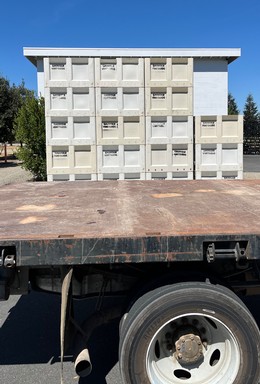Harvest 2024
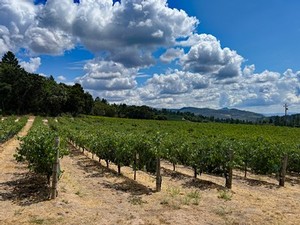
It's high harvest here in the Napa Valley. So far we've brought in Merlot for the rosé, the Sauvignon Blanc for the Sauvignon Blanc, then Merlot for red wine,  followed by Grenache, Cabernet Sauvignon from the Pool block and the Los Ricos Vineyard, and this past Thursday night, the Cabernet Franc from the Kemper block, along with the Mourvedre. (The photo on the left is the "juice sample" of rosé on its way into the lab.)
followed by Grenache, Cabernet Sauvignon from the Pool block and the Los Ricos Vineyard, and this past Thursday night, the Cabernet Franc from the Kemper block, along with the Mourvedre. (The photo on the left is the "juice sample" of rosé on its way into the lab.)
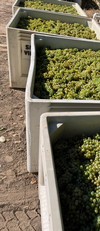 This leaves the Cabernet Sauvignon from the Brothers Vineyard and the Lost Orchard blocks, both of which will be picked tonight; and the Petit Verdot, which will be picked when it eventually decides it would like to be picked and has a moment to drop us a note.
This leaves the Cabernet Sauvignon from the Brothers Vineyard and the Lost Orchard blocks, both of which will be picked tonight; and the Petit Verdot, which will be picked when it eventually decides it would like to be picked and has a moment to drop us a note.
As to the character of the 2024 fruit and how it harbinges for the wines, the 2024 growing season, like 2023 before it, has been a real gift. After another winter with at least "average" rainfall, the vines entered the growing season strong and healthy. Bloom and set were near-ideal, with relatively short windows, promoting crop uniformity and, ultimately, quality.
In these days of climate change and global warming, the myriad wild cards conspicuoulsy include heat and fire. So far, 2024hasn't seen any major fires or ambient smoke in the Napa Valley; and while there has been some heat, it's been old-fashioned heat -- a week or so in early July when afternoon 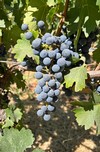 temperatures topped out at our place just below 100F; a couple of days in late August that were about the same; and today and tomorrow are forecast to hit the upper 90s.
temperatures topped out at our place just below 100F; a couple of days in late August that were about the same; and today and tomorrow are forecast to hit the upper 90s.
Overall, September has been fairy-tale extraordinary -- until this afternoon, daily highs have been in the 80s. With crop levels slightly above average in most blocks, this has given us very gradual ripening, with sugars slowly rising and acids holding nicely. (Sometimes with an assist -- the shadecloth rows below left are the Grenache before harvest.)
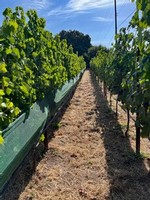 A word on what might sound like the many different lots coming in over harvest. We're a Cabernet house and it's our loadstone, with over 80% of our vineyards planted to various Cabernet clones. But just as we love the variation of the Cabernets coming from different strains planted at different places across the ranch, we also like to explore how other varieties perform there. The first European and middle-European cultivars were planted on the ranch in the 1870s and its reputation was originally built on Zinfandel. When our family arrived seventy years ago, after Phylloxera, two world wars, a Prohibition and a depression, the surviving vineyards were Petit Sirah and Golden Challesas, sprinkled with a rowdy and bewildering field blend of Carignon, Malvasia Binaca, Thompson seedless, and likely a dozen or so others. This is how winegrowing progresses -- explore, trial, error, guess, trial, error. It's one of the most frustratingly entertaining parts of winegrowing -- it takes generations to learn a site and figure out which grape varieties will show best there.
A word on what might sound like the many different lots coming in over harvest. We're a Cabernet house and it's our loadstone, with over 80% of our vineyards planted to various Cabernet clones. But just as we love the variation of the Cabernets coming from different strains planted at different places across the ranch, we also like to explore how other varieties perform there. The first European and middle-European cultivars were planted on the ranch in the 1870s and its reputation was originally built on Zinfandel. When our family arrived seventy years ago, after Phylloxera, two world wars, a Prohibition and a depression, the surviving vineyards were Petit Sirah and Golden Challesas, sprinkled with a rowdy and bewildering field blend of Carignon, Malvasia Binaca, Thompson seedless, and likely a dozen or so others. This is how winegrowing progresses -- explore, trial, error, guess, trial, error. It's one of the most frustratingly entertaining parts of winegrowing -- it takes generations to learn a site and figure out which grape varieties will show best there.
Add to that, we love diversity in the wines we make to pour at our home tables, so we eagerly try wines being made by others, 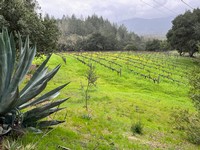 but also work to create diversity across our ground. The rosé is a family wine we make for ourselves and share with our club members and other customers. Same with the Sauvignon Blanc -- we farm one acre and drink about half of what we produce ourselves. And then we began bottling up what we had condescendingly named the "blending blocks" when they were originally planted -- Merlot, Cabernet Franc, and Petit Verdot. Yes, they're still often used in blends, but wow, do we enjoy them as wines. And now, with global warming nipping our heels, we're investigating how varieties which have evolved in warmer climates might do at the ranch -- the first glimpse will be the 2022 Mourvèdre, arriving this Fall.
but also work to create diversity across our ground. The rosé is a family wine we make for ourselves and share with our club members and other customers. Same with the Sauvignon Blanc -- we farm one acre and drink about half of what we produce ourselves. And then we began bottling up what we had condescendingly named the "blending blocks" when they were originally planted -- Merlot, Cabernet Franc, and Petit Verdot. Yes, they're still often used in blends, but wow, do we enjoy them as wines. And now, with global warming nipping our heels, we're investigating how varieties which have evolved in warmer climates might do at the ranch -- the first glimpse will be the 2022 Mourvèdre, arriving this Fall.
Onward.
